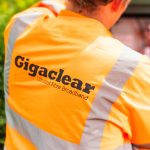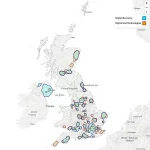The UK Top 30 Fastest and Slowest Streets for Broadband ISP Speed
A new study has used data from 1,064,681 consumer speedtests to produce a list of the top 30 fastest and slowest streets for download speed. Thorpe Lane in Trimley St Martin (Suffolk) was the slowest on 0.68Mbps, while Benford Avenue in Motherwell (Lanarkshire) was the fastest at 177.01Mbps.
The uSwitch.com report is based on speed tests conducted between 1st September 2016 and 1st August 2017 with 76,402 unique IP addresses (reflecting 9,099 postcodes). In order for a street to qualify for inclusion in the top or bottom 30, tests from at least 3 unique IP addresses and at least 10 residential properties were required at a postcode.
The research also claims that 20.6% of broadband users were found to receive speeds of under 10Mbps (below the forthcoming USO), while 8.6% crawl along at less than 5Mbps. On the flip side 36.7% now get average speeds of 30Mbps+ (up from 22% two years ago). NOTE: These particular findings were based on a much larger pool of 30,051,858 consumer speed tests.
Advertisement
First.. The Caveats
As usual it’s vitally important to explain that this data doesn’t necessarily mean what those in certain corners of the mass media might think. In particular, you should not to be equating speedtest based studies like this to reflect the availability of faster connections as the two are far from being in perfect sync.
Generally it’s estimated that fixed line “superfast broadband” (24Mbps+) networks should now be available to around 95% of UK premises (hopefully rising to 98% by 2020), although in reality many people have yet to upgrade (not everybody can afford, is aware of or even feels the need to upgrade). As a result a little under half the country still subscribe to significantly slower copper ADSL lines.
Connection performance can also be impacted by other factors, such as poor home wiring, user choice of package speed (e.g. even if 1Gbps is available most people may still pick a slower and cheaper package), network congestion and of course anybody conducting a test while being connected via WiFi is unlikely to get the best result. On top of that there are also some areas where the availability of superfast connectivity is still a big problem, such as in many rural villages and those locations where FTTC cabinets are full to capacity.
Something else to consider is that speed tests often muddle up residential and business connectivity, which can be a big problem where higher capacity links are concerned. A single multi-Gigabit leased line could disproportionately influence the results vs several slower home connections.
Advertisement
The Results
Now let’s get back to the results. Unsurprisingly uSwitch found that broadband users living in and around the UK’s largest cities are the most likely to find themselves with superfast speeds. This is a finding that will surely shock nobody, except perhaps those unfortunate enough to still be living inside an urban slow spot (e.g. there are a fair few to be found around London).
However the research itself is still useful for helping to track and show how adoption of faster broadband services is changing over time, although sadly uSwitch did not include an additional column to show how the same streets performed in 2016 vs 2017. Perhaps next time.
Side Note: Thorpe Lane, the supposed slowest street, appears to have FTTC available for faster speeds (up to around 20-24Mbps at best, so not quite superfast but closer than 0.67Mbps) and that’s by no means the only one.
The Top 30 Slowest UK Streets for Broadband
Advertisement
| Rank | Street name and location | Average download speed (Mbps) |
| 1 | Thorpe Lane, Trimley St Martin, Felixstowe, Suffolk | 0.679 |
| 2 | Cawcliff Lane, Wilton, Pickering, North Yorkshire | 0.711 |
| 3 | Old Road, Maisemore, Gloucester, Gloucestershire | 0.843 |
| 4 | Creeting Lane, Creeting St Peter, Ipswich, Suffolk | 0.857 |
| 5 | Opies Terrace, Four Lanes, Redruth, Cornwall | 0.867 |
| 6 | Hatton Green, Warwick, Warwickshire | 0.879 |
| 7 | Saltney Gate, Holbeach, Spalding, Lincolnshire | 0.886 |
| 8 | Rimini Road, Andover, Hampshire | 0.895 |
| 9 | Ashdown Drive, Chorley, Lancashire | 0.944 |
| 10 | Oldfort Road, Omagh, County Tyrone | 0.974 |
| 11 | Goudhurst Court, Milton Keynes, Buckinghamshire | 0.986 |
| 12 | Thirlmere Drive, Essington, Wolverhampton, Staffordshire | 0.990 |
| 13 | Nuthurst Street, Nuthurst, Horsham, West Sussex | 1.003 |
| 14 | Noak Hill Road, Billericay, Essex | 1.007 |
| 15 | The Gardens, Compton, Paignton, Devon | 1.015 |
| 16 | Sixteen Foot Bank, Stonea, March, Cambridgeshire | 1.026 |
| 17 | Kirkthorpe Lane, Heath, Wakefield, West Yorkshire | 1.028 |
| 18 | Craigflower Road, Glasgow | 1.028 |
| 19 | Pentland Way, Grangemouth, Stirlingshire | 1.038 |
| 20 | Thomas Penson Road, Gobowen, Oswestry, Shropshire | 1.049 |
| 21 | Willow Corner, Bayford, Hertford, Hertfordshire | 1.054 |
| 22 | Primrose Way, Minster on Sea, Sheerness, Kent | 1.116 |
| 23 | Bankhead, Milnathort, Kinross, Perth and Kinross | 1.122 |
| 24 | Slade Lane, Homer, Much Wenlock, Shropshire | 1.141 |
| 25 | Three Sisters Lane, Prestbury, Cheltenham, Gloucestershire | 1.146 |
| 26 | Church Lane, Kirkby-la-Thorpe, Sleaford, Lincolnshire | 1.147 |
| 27 | Shakespeare Avenue, Rayleigh, Essex | 1.154 |
| 28 | Glan-y-Nant, Fochriw, Bargoed, Gwent | 1.182 |
| 29 | Willow Close, Brinsworth, Rotherham, South Yorkshire | 1.207 |
| 30 | Wye Road, Boughton Lees, Ashford, Kent | 1.209 |
The Top 30 Fastest UK Streets for Broadband
| Rank | Street name and location | Average download speed (Mbps) |
| 1 | Benford Avenue, Motherwell, North Lanarkshire | 177.009 |
| 2 | Sheskin Gardens, Londonderry, County Londonderry | 158.497 |
| 3 | Crosswood Road, Swindon, Wiltshire | 158.355 |
| 4 | Astill Lodge Road, Leicester, Leicestershire | 155.856 |
| 5 | Olive Hill Road, Halesowen, West Midlands | 152.093 |
| 6 | Bonny Grove, Middlesbrough, North Yorkshire | 151.057 |
| 7 | Red Willow, Harlow, Essex | 143.700 |
| 8 | Arden Oak Road, Birmingham, West Midlands | 142.576 |
| 9 | Airbles Crescent, Motherwell, North Lanarkshire | 141.344 |
| 10 | Dearden Street, Little Lever, Bolton, Greater Manchester | 139.524 |
| 11 | Holmrook Road, Carlisle, Cumbria | 138.353 |
| 12 | Ullswater Drive, Wetherby, West Yorkshire | 137.424 |
| 13 | Chestnut Drive, Pinner, Greater London | 134.030 |
| 14 | Kingsdyke Avenue, Glasgow | 132.797 |
| 15 | Oaklands Grove, Waterlooville, Hampshire | 132.449 |
| 16 | Chatham Road, Kingston upon Thames, Greater London | 131.076 |
| 17 | Wordsworth Drive, Rotherham, South Yorkshire | 130.281 |
| 18 | Claybridge Road, London, Greater London | 129.757 |
| 19 | Simshill Road, Glasgow | 129.386 |
| 20 | Fairmead Mews, Lower Burraton, Saltash, Cornwall | 129.322 |
| 21 | Baxter Avenue, Southend-on-Sea, Essex | 129.115 |
| 22 | Acer Close, Lincoln, Lincolnshire | 128.933 |
| 23 | Larch Avenue, Newton-le-Willows, Merseyside | 128.472 |
| 24 | Inmans Road, Hull, East Yorkshire | 128.290 |
| 25 | Hempstead Road, Gillingham, Kent | 128.248 |
| 26 | Beechfield Road, Smethwick, West Midlands | 127.686 |
| 27 | Bodmin Avenue, Slough, Berkshire | 127.270 |
| 28 | Taeping Street, London, Greater London | 126.510 |
| 29 | The Rake, Wirral, Merseyside | 126.461 |
| 30 | Mauchline Court, Hamilton, South Lanarkshire | 125.773 |
Now a few words just in from the ISPA.
Andrew Glover, ISPA Chair, said:
“ISPA understands the frustrations of those unable to receive a good quality broadband connection and this is why our members are continually working to boost broadband speeds, from alternative networks delivering solutions on a regional or local basis using a variety of technologies to a nationwide rollout programme that covers 94% of the UK. In addition, everyone in the UK should soon have a right to request a minimum broadband connection of 10Mbps under the broadband Universal Service Obligation.
Thanks to the continued investment and innovation of our members, broadband speeds are increasing each year, with the average speed of 37Mbps in 2016, up from 28Mbps in 2015 and 23Mbps in 2014, according to the regulator. ISPs are also committed to providing their customers with transparency about broadband speeds, including an estimate of the actual speed their line is capable of receiving before entering into a contract and providing customers with the ability to exit the contract if the speeds fall below a certain level.
We advise customers to speak to their ISP about steps they may be able to take to improve the speeds they actually receive as a number of factors can affect the actual speed many of which are outside of an ISP’s control. These include home wiring, the number of devices sharing a connection, the quality of equipment and the limitations of web-based speed tests which often only provide a limited snapshot of performance.”
Mark is a professional technology writer, IT consultant and computer engineer from Dorset (England), he also founded ISPreview in 1999 and enjoys analysing the latest telecoms and broadband developments. Find me on X (Twitter), Mastodon, Facebook, BlueSky, Threads.net and Linkedin.
« Openreach Pause UK Trial of G.INP Fix for ECI FTTC Broadband Cabs UPDATE2
UK ISP John Lewis Broadband Offers FREE Google Home »

















































Comments are closed